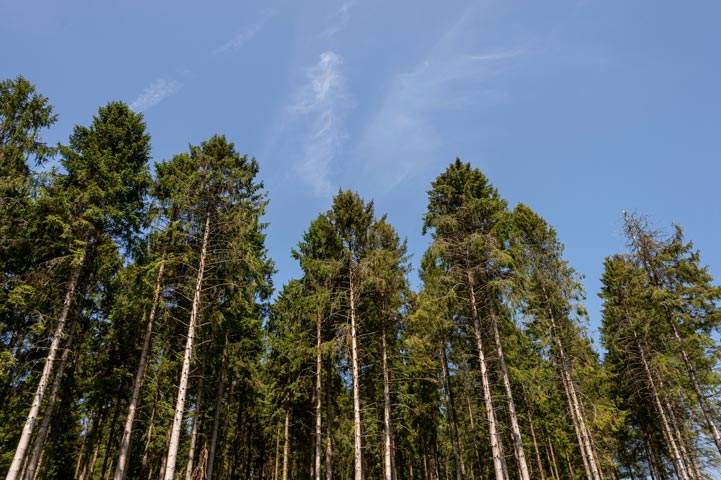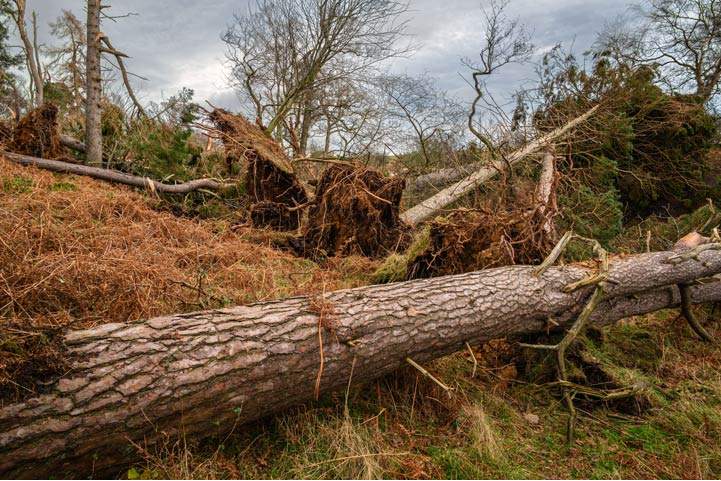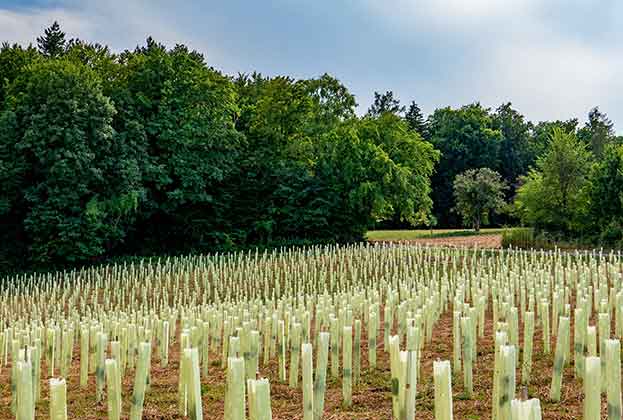The effects of climate change mean landowners need to start adapting to its inevitable consequences
At COP21 in 2015, world leaders agreed to substantially reduce global greenhouse gas emissions and pursue efforts to limit temperature increase to 1.5°C above pre-industrial levels. This accord came to be known as the Paris Agreement. February 2023 to January 2024 reached 1.52°C of warming; that’s the first time global warming has exceeded 1.5°C across an entire year. This does not break the Paris Agreement, but it is a step closer to doing so in the long term.
With global emissions still growing, climate change and its effects seem inevitable. What does that mean for forestry? Summers will be drier, winters will be wetter, and both will be warmer with an increase in extreme events, including storms. While warmer weather means longer growing seasons and potentially greater yields, storms have already shown their capacity to cause extensive damage and wildfires have destroyed large swathes of woodland over the last five years, especially in North America, Australia and warmer parts of Europe. The seeming inevitability of climate change means landowners should be adapting to the equally inevitable consequences.
Frequency
There have been 70 named storms in the UK since 2015. During this time, the joint highest annual number recorded was eleven in the 2015/16 storm season. Five storms followed during the 2016/17 season. The lowest number of named storms was four, recorded in 2022/23, and this was followed by eleven (the joint highest) during 2023/24. If there is another storm before the end of August 2024, it will be a record-breaking year. This pattern clearly illustrates the volatility and is mapped out in figure 10.
Power
Volatility and unpredictability continue when considering the maximum gust speed of storms across a season. Eunice stands out as the most powerful. A gust of wind registered 122 mph over the Isle of Wight – the fastest gust ever recorded in England. The following storm season, gust speeds did not exceed 100 mph except at mountain summit stations.
Some of the most costly storm events come in clusters. Dudley, Eunice and Franklin were all named within less than a week of each other and cost insurers an estimated half a billion pounds. In February 2020, storms Ciara and Dennis, followed by Jorge, hit the UK and brought widespread flooding. Before Storm Kathleen, there was never more than 27 days between the naming of storms in the 2023/24 season. As if to reinforce the message of unpredictability, Storm Babet caused a similar amount of cost, but stood weeks apart from other storms in the 2023/24 season.
Storm Arwen does not necessarily stand out in figure 10, but was nonetheless one of the most destructive storms in recent memory as it approached from the north east, rather than the south west as is usual. This meant trees were battered from a different angle and their pre-existing resistance to strong winds were rendered less effective. Climate change and its effect on the jet stream could well see unusual approaches become more common.
Are trees weaker?
Climate change means growing seasons can be as much as three weeks longer, which means annual tree growth can be greater. However, it could also mean weaker, less resilient trees too. In North America and Europe, trees have grown between 32% and 77% faster since 1870, according to a 2014 study published in Nature Communications. At the same time, a study by the Technical University of Munich found as the growth rate increased, the density of the wood dropped by 8-12%.
This has a range of impacts. First, the reduced density of open-grained wood reduces the volume of carbon absorbed and can reduce the strength and lifespan of the tree, though this is highly dependent on the species. Climate change seems to be compromising some of the most sought-after benefits of timber, from its inherent quality to its ability to absorb carbon dioxide and aid in combatting climate change. Second, the lighter wood is also less dense and has a lower calorific value, impacting its performance in applications such as construction and energy production. Third, the weaker wood, especially when coupled with rapid vertical growth, also increases the risk of damage due to weather events.

TIMBER MARKET UPDATE
The Coniferous Standing Sales Price Index for Great Britain was -28.1% lower in real terms in the year to September 2023, compared with the previous year (figure 11). The Index has fallen since peaking in March 2022, albeit this latest decrease demonstrates a slower rate of decline. Inflation and consequent rises in interest rates have contributed to this downward pressure. According to NHDB Residential Construction Statistics, housing starts in England were down -19% from 2022–2023 and -22% in Scotland during the same period.
However, over the long term, demand for timber looks strong. The FAO forecasts it to triple by 2050, with increasing demand from a rising global population combined with increasing demand for sustainable building products.
Mitigating risk through woodland management
Facing a storm is inevitable, however, throughout the lifetime of a forest, measures can be taken to mitigate the risk of storm damage losses.

Ground preperation
Correct ground preparation aids tree establishment, which provides resilience during a storm. This can include dealing with harvesting residues, weed control and drainage promotion. The benefits of ground preparation should also be balanced with the amount of site disturbance. Cultivation is undertaken to aid establishment, but also improve rooting depth and therefore help promote stability. Benefits are not limited to risk mitigation however, cultivation can improve site discipline and so benefit future thinning. Ground preparation can improve soil temperature regulation, moisture availability and aeration.
Planting
Trees that form an abrupt edge of a forest will be subjected to severe wind. Though at risk, they also act as a solid body, channelling the wind upwards. As this airflow returns to the ground, there will be a further zone of increased risk and it is here where damage often appears to be initiated in storm events.
Graded edges can be made through tapering, where the height of trees increases from the forest edge. Even a narrow tapered strip, equivalent to half of the tree’s height in width, can be effective. While tapered edges can be created later in the forest’s life by topping edge trees, this increases the chances of tree mortality and is not recommended. Instead, the practice should be initiated early in the life of the forest.
Additionally, graduated density can further enhance wind protection at the edge of a wooded area and should be established early on. Graduated edges see the density of planting increase from the forest edge and can be achieved by planting or respacing the edge trees to wider spacing. However, avoid modifying spacing when the forest nears maturity as the respaced trees will not be adapted to increased wind exposure.
Combining graduated density with a tapered tree height more closely resembles natural forest growth and improves resilience to wind loading.
Management
A hazard assessment will determine which forest areas are most at risk of storm damage. Ongoing management of the forest will be determined by the risks identified. In high-risk areas, for example, thinning should be avoided and rotations shortened. Wind risk increases immediately following stand thinning, as the wider spacing exposes trees to higher wind speeds, which the trees are not adapted to resist. Particular attention should be taken to stand height and to not over-extend rotations in exposed areas.
This is not to say that continuous cover forestry (CCF) is not an option. Following thinning, trees adjust to the new wind regime and within a few years can improve on their initial stability. Where wind risk is low, CCF can bring alternative benefits too, such as a more regular income from thinning and enhanced biodiversity. While wind is an increasing concern, management must maintain a broad, all-encompassing perspective.
After a storm
The priority after a storm must be safety, both of workers on the site and visitors. Once a site has been made safe, work can begin to minimise financial losses from any felled timber.
Maintaining robust inventory data allows the most at-risk trees to be addressed first. For example, timber from pine and snapped trees degrades quicker and should be prioritised over trees that are still attached to a root plate as these are unlikely to degrade for months.
Once cut, trees will degrade more quickly so it is essential to have a buyer in place. In the meantime, a Felling Licence or a Felling Permission in Scotland will need to be obtained. Also, ensure access to the woodland is safe and sufficient for loading and transporting timber. Once harvested, restocking can occur, taking good design into account to minimise the chances of further wind damage in the future.
Read the articles within The Forestry Market – 2024 below.
.jpg)
